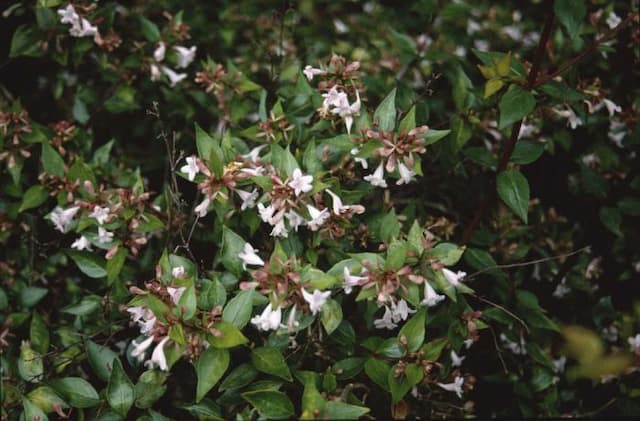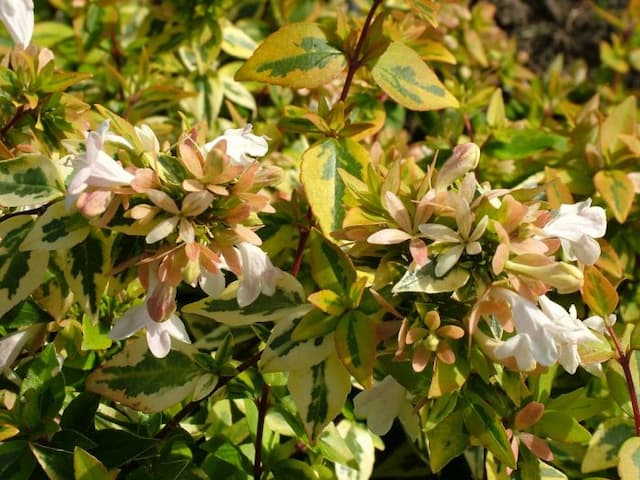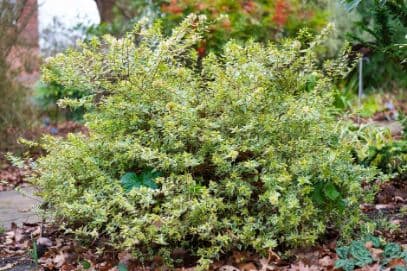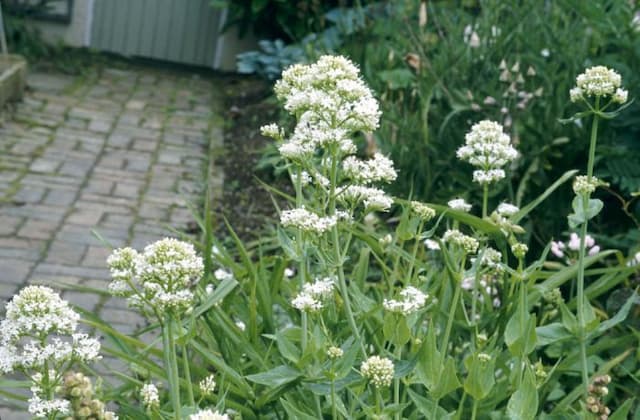Beauty Bush Kolkwitzia amabilis 'Pink Cloud'

ABOUT
Pink Cloud is a captivating deciduous shrub known for its stunning floral display. It showcases an abundance of bell-shaped flowers that cover the shrub in a soft, pink hue, akin to a cloud at dawn. The flowers are delicately framed by a fine flare of yellow throats, enhancing their charm. The plant presents a graceful, arching habit with branches that often give a fountain-like appearance, contributing to a sense of movement and elegance in the garden landscape. Throughout the seasons, Pink Cloud offers visual interest—with lush green foliage that takes the stage during the growing season, later transitioning to a modest display of autumn colors as the leaves turn with the season's change before they drop. The blooms are not only attractive but are also known to be a magnet for pollinators such as bees and butterflies, adding to the environmental benefits of this beautiful shrub. When not in bloom, the dark green leaves provide a dense backdrop that can serve as a natural screen or backdrop for other garden plants. Overall, Pink Cloud is a romantic and enchanting addition to any garden space, bringing with it a touch of whimsy and a burst of pastel beauty that's hard to overlook when in full bloom.
About this plant
 Names
NamesFamily
Caprifoliaceae.
Synonyms
Beauty Bush, Pink Cloud Beauty Bush, Linnaea Amabilis 'Pink Cloud'.
Common names
Kolkwitzia amabilis, Linnaea amabilis.
 Toxicity
ToxicityTo humans
Beauty bush, the common name for Kolkwitzia amabilis 'Pink Cloud', is not considered toxic to humans. Therefore, ingestion of this plant typically does not cause any harmful symptoms. However, it is always advisable to avoid eating ornamental plants as they are not intended for human consumption and individual sensitivities can vary.
To pets
Beauty bush is also not considered toxic to pets. There should be no toxic effects if pets happen to ingest parts of this plant. However, as with humans, it is generally recommended to prevent pets from consuming plants not intended for their diet to avoid any potential gastrointestinal upset simply from eating non-food items.
 Characteristics
CharacteristicsLife cycle
Perennials
Foliage type
Deciduous
Color of leaves
Green
Flower color
Pink
Height
6-8 feet (1.8-2.4 meters)
Spread
6-8 feet (1.8-2.4 meters)
Plant type
Shrub
Hardiness zones
5
Native area
China
Benefits
 General Benefits
General Benefits- Attractive Blooms: Beauty Bush 'Pink Cloud' offers abundant pink, bell-shaped flowers in late spring, creating a visually appealing display.
- Landscape Ornamentation: With its arching branches and attractive foliage, it serves as an excellent addition to gardens and landscapes.
- Wildlife Attraction: The flowers of the Beauty Bush are attractive to pollinators such as bees and butterflies, supporting biodiversity.
- Low Maintenance: Once established, Beauty Bush is a low-maintenance plant that requires minimal care, making it suitable for gardeners of all skill levels.
- Drought Tolerance: After establishment, Beauty Bush has moderate drought tolerance, making it suitable for regions with occasional water scarcity.
- Erosion Control: The branching root system of Beauty Bush helps in stabilizing soil and controlling erosion on slopes.
- Seasonal Interest: Beauty Bush offers year-round interest with flowers in spring, lush foliage in summer, and sometimes a display of yellow to purple foliage in fall.
 Medical Properties
Medical PropertiesThis plant is not used for medical purposes.
 Air-purifying Qualities
Air-purifying QualitiesThis plant is not specifically known for air purifying qualities.
 Other Uses
Other Uses- Wildlife Habitat: Beautybush can provide shelter and nesting sites for birds within its dense branches.
- Garden Sculpture: Pruned branches of Beautybush can be used to create natural garden sculptures or decorative forms.
- Natural Fence: When planted in rows, Beautybush can form an informal, flowering hedge or privacy screen in the landscape.
- Ecological Studies: Beautybush can be utilized in research focusing on pollinator attraction and habitat preferences due to its appeal to bees and butterflies.
- Photography Backdrop: The vibrant blooms of Beautybush make it a popular choice for garden photographers looking for captivating backdrops.
- Erosion Control: Its root system can help stabilize slopes and areas prone to erosion in the landscape.
- Artistic Inspiration: The flowers and overall form of Beautybush can serve as inspiration for artists and craftspeople.
- Sensory Garden Element: With its textured foliage and fragrant flowers, Beautybush can be included in sensory gardens designed for therapeutic and educational purposes.
- Seasonal Celebrations: Branches bearing flowers or berries may be cut and arranged for use in spring and summer festivities.
- Livestock Shade: When planted in pastures, larger specimens of Beautybush can provide shade for small livestock during hotter months.
Interesting Facts
 Feng Shui
Feng ShuiThe Beauty Bush is not used in Feng Shui practice.
 Zodiac Sign Compitability
Zodiac Sign CompitabilityThe Beauty Bush is not used in astrology practice.
 Plant Symbolism
Plant Symbolism- Beauty: Known commonly as the Beauty Bush, Kolkwitzia amabilis 'Pink Cloud' symbolizes beauty due to its visually appealing pink blooms that create a picturesque display in gardens.
- Romance: The soft pink flowers are often associated with romantic sentiments, evoking tender and sweet emotions.
- Renewal: As a deciduous shrub, the Beauty Bush's cycle of shedding its leaves in the fall and blossoming anew in spring reflects themes of revival and new beginnings.
 Water
WaterBeauty Bush should be watered deeply once a week during its first growing season to help establish roots. Once established, it's fairly drought tolerant but does best with regular watering during dry periods. Depending on the climate and soil type, this may mean providing approximately 1 to 1.5 gallons of water every other week during hot and dry weather. During the winter or in cooler regions, watering can be reduced but ensure the soil doesn't completely dry out, especially for plants in containers.
 Light
LightBeauty Bush thrives in full sun to partial shade. For the healthiest growth and best flowering, plant it in a spot where it will receive at least 6 hours of direct sunlight each day. However, in hotter climates, it can benefit from some afternoon shade to protect it from the most intense heat of the day.
 Temperature
TemperatureBeauty Bush is hardy and can tolerate a wide range of temperatures. It is known to withstand a maximum temperature of around 85-90 degrees Fahrenheit and can survive minimum winter temperatures down to about -10 degrees Fahrenheit. Ideal growing temperatures are between 60 and 75 degrees Fahrenheit, which encourage healthy growth and flowering.
 Pruning
PruningPrune the Beauty Bush immediately after flowering, as it blooms on old wood. Remove any dead or damaged branches and thin out as needed to maintain its shape and encourage air circulation, which can help prevent disease. It's generally recommended to prune no more than one-third of the branches in a given year, to support healthy growth and abundant blooms next season.
 Cleaning
CleaningAs needed
 Soil
SoilBeauty Bush 'Pink Cloud' thrives best in well-draining soil enriched with organic matter, with a pH that is slightly acidic to neutral, ranging from 6.0 to 7.0. A mix that includes peat, loamy soil, and a component for drainage, such as perlite, would provide an ideal growing medium for this shrub.
 Repotting
RepottingThe Beauty Bush 'Pink Cloud' typically does not require frequent repotting as it's a larger shrub best suited for outdoor gardens. It is normally planted in the ground where it can spread its roots without the need for repotting.
 Humidity & Misting
Humidity & MistingBeauty Bush 'Pink Cloud' is adaptable to a wide range of humidity conditions outdoors and does not have specific humidity requirements. It fares well in the average humidity levels found in most temperate climates.
 Suitable locations
Suitable locationsIndoor
Not suitable for indoor growth due to size.
Outdoor
Plant in sun to part shade, well-drained soil, water regularly.
Hardiness zone
4-8 USDA
 Life cycle
Life cycleBeauty Bush 'Pink Cloud' (Kolkwitzia amabilis 'Pink Cloud') begins its life as a seed that germinates in spring when soil temperatures are favorable. It grows into a young seedling, which develops a root system and foliage as it becomes established. With proper care, this deciduous shrub enters a vegetative stage, producing long, arching branches and lush green leaves during the growing season. In late spring to early summer, the plant reaches maturity and produces an abundance of small, pink, bell-shaped flowers that are particularly attractive to pollinators. After flowering, it sets seed, which can be dispersed by wind or wildlife, potentially giving rise to new plants. In the autumn, Beauty Bush 'Pink Cloud' prepares for dormancy by shedding its leaves, thus completing its annual life cycle.
 Propogation
PropogationPropogation time
Early Spring
Kolkwitzia amabilis 'Pink Cloud', commonly known as Beautybush, is best propagated through softwood cuttings. This method is typically undertaken in late spring or early summer, coinciding with the period when new growth is mature enough yet still tender. To propagate via softwood cuttings, one starts by selecting a healthy shoot and making a cut to harvest a piece about 4 to 6 inches (approximately 10 to 15 centimeters) in length. The cutting should have several leaves but the lower half should be stripped of foliage. The base is then dipped in rooting hormone to encourage root development and planted in a mixture of peat and perlite or sand to provide a well-draining growing medium. Cuttings should be kept in a warm, humid environment until roots develop, after which they can be transplanted into individual pots for further growth before eventual planting in their final location.









